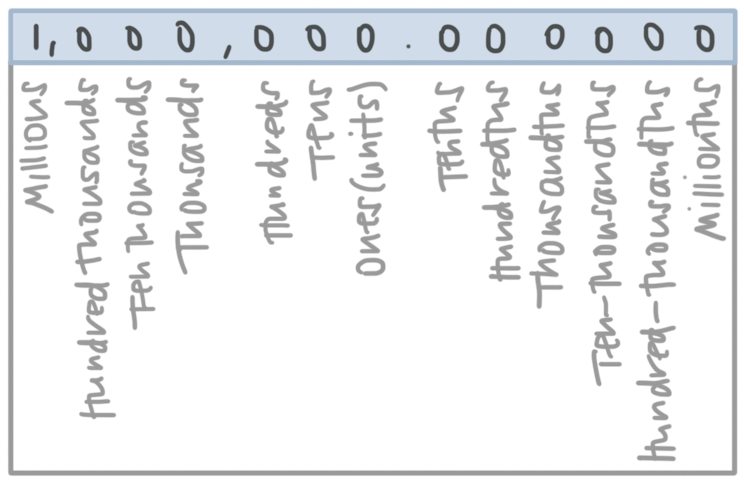Finding place value of a particular digit
Place values around the units place
When we talk about place value, we’re talking about the value of the location of a particular digit within a given number (the value of the place where that digit is located within that number). Given a number like ???4.321???, place value is what allows us to easily say where the ???3??? is located or where the ???1??? is located.
If we both know place value, then I can tell you that the ???3??? is in the “tenths place” and that the ???1??? is in the “thousandths place,” and you’ll know exactly what I mean.
Hi! I'm krista.
I create online courses to help you rock your math class. Read more.
Below is a table of place values. You can extend this table further in both directions. The table centers around the ones place (also called the units place), which is the place of all single-digit integers.
From there, you’ll notice that if you move one place to the left, you get to the “tens” place, and if you move one place to the right, you get to the “tenths” place. As you continue to move to the left, you have the “hundreds” and “thousands” places, but as you move to he right you have the “hundredths” and “thousandths” places.
The ones (units) place is separated from the tenths place by a symbol that looks like a period, but when we use that symbol in a decimal we call it a decimal point.
In this table, the location of the ???1??? is the place value we’re talking about. For example, the ???1??? in ???100,000??? is in the “hundred thousands” place.
How to identify place values for particular digits
Take the course
Want to learn more about Pre-Algebra? I have a step-by-step course for that. :)
Heading
Example
In which place is the ???7??? located?
???32.18476???
The ???7??? is four places to the right of the decimal point, which means it’s in the “ten-thousandths” place. We could even break down each place in this number:
we use the term “decimal place” to mean a place to the right of the decimal point.
You may wonder what the place values of the digits in a number actually tell us. Well, they tell us the “values” of those digits in that number. Let's look at an example.
Consider the number ???2,635.487???. The ???5??? in the ones (units) place tells us that it's worth ???5\times1???, or ???5???, the ???3??? in the tens place tells us that it's worth ???3\times10???, or ???30???, and so on.
The ???4??? is one place to the right of the decimal point, so in decimal form its value is ???0.4???. To express its value as a fraction, we multiply ???4??? by ???1/10???.
The ???8??? is two places to the right of the decimal point, so in decimal form its value is ???0.08???. To express its value as a fraction, we multiply ???8??? by ???1/100???.
The ???7??? is three places to the right of the decimal point, so in decimal form its value is ???0.007???. To express its value as a fraction, we multiply ???7??? by ???1/1000???.
Here’s a chart that summarizes the value of each digit:
Another aspect of decimals that you should be aware of is that we use the term “decimal place” to mean a place to the right of the decimal point. When we say that a number has a certain number of decimal places, we're referring to the number of digits to the right of its decimal point.
For example, the number ???47.603??? has five digits (???4???, ???7???, ???6???, ???0???, and ???3???), but it has only three decimal places (the tenths, hundredths, and thousandths places) since there are only three digits to the right of its decimal point. The digits in the first, second, and third decimal places are ???6???, ???0???, and ???3???, respectively.









